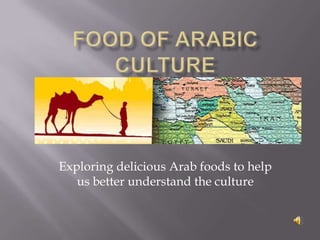
Exploring the Food of Arab Culture
- 1. Food of Arabic Culture Exploring delicious Arab foods to help us better understand the culture
- 3. A common ingredient in many of the deserts of Arab culture include a homemade syrup. This syrup is made of sugar, water, and a little bit of lemon juice.
- 5. Knafe Kunāfah/Künefe The main ingredients include a shredded dough, cheese, and syrup. Orange dye is used to make the shredded dough so bright and sugar is added to make the cheese sweeter.
- 6. Luqamait (Also known as Arab donut holes) These tasty delights are made of butter, flour, sugar, milk, and cardamom. After the dough is fried, the syrup is added for additional flavor. These are usually served during Ramadan.
- 7. Mamoul (ma-moul) The dough is made out of fine sugar, wheat flour, butter, and water. The filling is made of dates (without seeds), and butter. The designs are traditionally etched on the dough by hand. Powdered sugar is used for an additional touch.
- 8. Main Course and sides There are variety of main course dishes throughout the Arab culture. Some recipes are slightly changed between different cities, but the overall ingredients remain consistent throughout the culture.
- 9. Hummus [hoom-uhs] The main ingredient in hummus is chickpeas. The chickpeas are ground and mixed with lemon juice, oil, and garlic. Hummus can be served as an appetizer or side and usually accompanied by pita bread.
- 10. Falafel (fuh-lah-fuhl) The main ingredient in falafel is also chickpeas. The chickpeas are ground and mixed with spices. Then they are fried into these lightly fried into balls. The outside is crunchy, but the inside is soft. Falafels can be served as an appetizer or side and usually accompanied by hummus and pita bread.
- 11. Warak-el-Dawali (stuffed grape leaves) Stuffed grape leaves are made of fresh vine leaves (also available in jars), ground lamb, rice, pepper, tomatoes. The rice is mixed with the ground lamb and pepper, then rolled nicely into the image above. The grape leaves are steamed with fresh tomatoes and water. They can be served as a side dish or a main course.
- 12. Labneh (strained yogurt) This is yogurt that is strained in a cloth and has a texture in between that of yogurt and cheese. It is served with olive oil as a dip and accompanied by pita bread and olives.
- 13. Makloubeh (Maalouba) This meal is always considered a main course in Arab culture and is popular in Palestine. The name means “upside down” which is exactly the way this dish is served. It has lamb, rice, cauliflower, and eggplant. It is also topped with toasted almonds and pine nuts.
- 14. Couscous (kuskus) Couscous is made by rolling and shaping wheat flour. Often times it can be purchased already shaped because the process can be very time consuming. Couscous is usually served with broth and chicken or lamb as a main course. It can also be served as a side course with sugar.
- 15. Shawerma (lamb, beef, or chicken) Shawerma is considered fast food in Arab culture. It is made of marinated meat including chicken, lamb, or beef on a stick to roast around the flame for hours. It is then sliced and served in sandwiches with hummus, and vegetables such as pickles, peppers, onions, and tomatoes.
- 16. Mmmmmmm……… As you can see Arab culture has a variety of foods including desserts, main courses, and sides. Each one of these foods may be slightly changed in each country, but the main ingredients are usually consistent. All of these foods can teach you something new about Arab culture. You can also visit your local Middle Eastern restaurants and compare those foods to the traditional foods you have learned about.
- 17. Are you hungry yet?